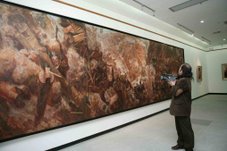
"Among the pieces on display is a comic photo collage by the Blue Noses group that appears to depict Putin, Osama bin Laden, and President George W. Bush lounging together in boxer shorts like three drunken Russians."
The International Tribune today has
a review of the
"Second Moscow Biennale." [
English web site here.]
As Wikipedia accurately describes, the
original Biennale art show took place in Venice. Since then, however, a lot of other cities have been getting into the act.
Two years ago, the main venues for the First Moscow Biennale were in the staid and oh-so-official (former) Lenin Museum, the Pushkin State Museum of Fine Arts, and the State Tretyakov Gallery, among others. This year, one important venue is in a half-finished wing of the giant Tsum department store:
The art of shopping, rather than art, might be foremost on the minds of shoppers at TSUM, the Moscow department store, but they have a surprise awaiting them as they round the corner from racks of Armani Junior and Miss Blumarine childrenswear. A nondescript white door opens to a huge concrete hall full of dozens of screens showing continuous American video art in a cacophony of images and sounds. The videos, some offering commentary on consumer culture, are part of the main project of the Second Moscow Biennale of Contemporary Art, which is entitled "Footnotes on Geopolitics, Market, and Amnesia."
* * *
The entire fourth floor of an unfinished new wing of TSUM — with construction workers busily drilling on walls — has been taken over by the biennale, which opened March 1 and runs until April 1.
* * *
The biennale's festive opening on March 1 in the store's cosmetics department featured speeches by Mikhail Shvydkoi, the director of Russia's Federal Culture and Cinematography Agency, a branch of the Culture Ministry, city officials, and a U.S. Embassy representative.
The Russian deputy director of Center for Museums and exhibitions, Joseph Backstein, adds, "The ladies who were shopping probably didn't know what hit them."
Among overtly political videos and other
avant-garde works, on display in the satellite venue of the State Trekykov Gallery is a collage by the notorious
Blue Noses group. Culture reporter
Sophia Kishkovsky writes:Among the pieces on display is a comic photo collage by the Blue Noses group that appears to depict Putin, Osama bin Laden, and President George W. Bush lounging together in boxer shorts like three drunken Russians. It hangs near a new video installation that includes a recording of Putin's New Year's address to the nation — set to a mocking laugh track.
Russian, American, and Islamic fundamentalist leaders aren't the only targets of the
"Sots" art movement, as it is known. South American and Asian politicians, past and present, also come in for their share of send-ups -- including Mao Zedung, Deng Xiaoping, and Zheng Zhimin. Their visages appear in another exhibition titled, somewhat mysteriously,
"We Are Your Future."It might as well have been titled "We
Ate Your Future."
Among the Chinese artists participating are Xu Bing, Wang Guangyi, Sui Jianguo, Fang Lijun, Yue Minjun, Yan Lei, Ai Weiwei, Chen Wenbo, Liu Xiaodong, Yin Xuizhen, Song Dong, Huang Yan, Peng Yu, Sun Yuan, and Qiu Zhijie.
Political art -- a term some critics deride as meaningless but which nevertheless is a useful way of describing hyper-contemporary works like the Blue Nose painting shown above -- often is fun to see and satisfying on a purely emotional level, particularly for those disaffected with the politics and politicians of their time. Whether it has staying power as fine art is another matter, one that cannot easily be assessed by contemporaries.
Some art movements considered
avant-garde in their time retain an appeal and emotional impact far beyond the moment of their creation. One thinks of
Picasso's Guernica or
Leon Golub's Interrogation III, for example, works of art executed more than a generation ago yet which speak to us in our own time, too.
But art history also is littered with the abandoned carcasses of other political art movements. As
Gregory Sholette, who was himself "associated with Political Art Documentation and Distribution, or PAD/D" in the mid-1980's -- puts it in a short essay titled
"Snip, Snip, Bang, Bang: Political Art Reloaded", one can name any number of failed art movements in the U.S., alone, that have become "unceremoniously submerged, partially or wholly, beneath the waves of normative art history":
PAD/D, Group Material, the Art Workers Coalition, Artists Meeting for Cultural Change, The Guerilla Art Action Group, Paper Tiger, SPARC, Carnival Knowledge*** The record of their activities now exists within a shadow archive brimming with other examples of anonymous histories, collectivist production, and unrecognized modes of creativity.
Still, even such 'disappeared' movements, as Shollette says, constitute a "phantom archive" with an "off-stage presence" that influences both the culture and artistic expression of future generations and the culture in which they work.
As Oscar Wilde argued a century ago in his famous
"Lecture to Art Students," the object of art is "to stir the most divine and remote chords which make music in our souls." Ultimately, art must be judged on its universality of appeal to the basic human condition:
"All good work looks perfectly modern: a piece of Greek sculpture, a portrait of Velasquez -- they are always modern, always of our time."
In one sense, it is appalling to think that the image of Bush, Putin, and Ossama bin Laden cavorting in their underwear might have universal appeal for future generations. But if it releases the chains of artistic expression for artists around the globe, so much the better.
At least it could then be said that George W. Bush did
something to make the world a better place.














